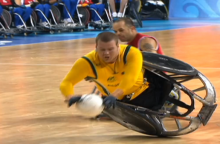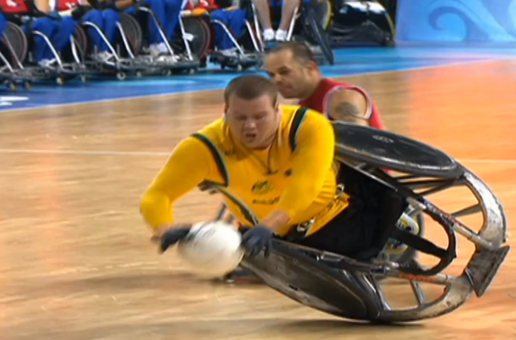Scheduled Website Maintenance
We’re currently in the process of moving to a new and improved server environment. During this transition, the website may experience brief interruptions or temporary outages.
We appreciate your patience while we complete this upgrade. Service will return to normal shortly, with improved performance and reliability.
Thank you for your understanding.
There are some pundits who think there is little in common between Wheelchair Rugby and the able-bodied version of rugby. In plenty of respects they are correct.
The wheeled game is played indoors, by four players a side. There are no lineouts or scrums, no kicks in general play (or grubber kicks) or conversions, and the ball is round, not oval. It is almost the bastard child of a liaison between ice hockey, water polo and basketball, which is understandable because the founders were Canadian. The similarities to rugby are that it is an end-zone invasion, full-contact game with offensive and defensive roles — and more significantly, there are roles within the game for players of all shapes, sizes and physical disabilities.
This game is tough and physical and is played with as much passion as any game of able-bodied rugby I have seen. Sure, the ball isn’t oval, but the players don’t have the physical ability to bend down and pick up an oval ball. It is played indoors, on an ‘oval’ measuring 28 metres by 15 metres. It’s not a game for softies and I wouldn’t want to meet a pack of these players on the back streets of Kings Cross at five in the morning.
These are just some fairly heavily disabled people who want to have a great time with their mates, playing a contact sport that uses their wheelchairs to best advantage. The collisions and physicality are very rugby-like. The game is fluid and fast-moving, with possession switching back and forth between teams as play continues. I am not unhappy that they have chosen to associate the name of their sport with rugby.
Wheelchair Rugby at the Paralympics
At the 1996 Atlanta Paralympics, Wheelchair Rugby was introduced as a demonstration sport, and while the Steelers were there, they were eliminated in the preliminary rounds. The USA beat Canada to take that first gold medal. Wheelchair Rugby was granted full medal status at Sydney 2000 Paralympics. Since then, the Steelers have twice been the Paralympic bridesmaids, to the New Zealand team at Sydney 2000, and to the USA team at Beijing 2008.
I was first introduced to the sport at Sydney 2000, and believe me, watching the game live, up-close and friendly, you quickly forget that the athletes, in many instances, have severe physical handicaps. The game is tactical, high speed and brutal with no quarter asked or given. While the oval is only 28 metres long, the athletes can get up to speeds of 30km/h in their specially modified wheelchairs, which look more like something from a Mad Max Demolition Derby than your Grandmother’s Tesla XL Mobility Scooter.
Rules

To be eligible to play wheelchair rugby, athletes must have some form of disability with a loss of function in both the upper and lower limbs. In many instances, life has not dealt a fair hand to these guys, either genetically, accidentally or medically. The majority of wheelchair rugby athletes have spinal cord injuries at the level of their cervical vertebrae. Others have multiple amputations, polio, or neurological disorders such as cerebral palsy, or forms of muscular dystrophy, among other medical conditions.
Players are classified according to their functional level and are assigned a point value ranging from 0.5 (the lowest functional level) to 3.5 (the highest). The total classification value of all four players on the court for a team at one time cannot exceed eight points. The star of the Steelers, Ryley Batt, who some claim is the world’s best player and the sport’s equivalent of Michael Jordan, is classified 3.5. When Ryley is on the field, coach Brad Dubberley has to play some lower classification players to stay within the allowance. Here is another parallel with rugby: for every David Campese playing, the coach has to play a Rodzilla fatty equivalent to stay within the allowable classification points limit. These lower classification players have a very important role in blocking the other team’s players to create the space for the 3.5 classification rockstars like Ryley Batt and 26-year-old Chris Bond to shine. A team configuration with two 3.5 classification players along with two 0.5 classifications is called a High-Low strategy.
The game is played over four eight-minute quarters, with a forty-second shot clock requiring either a score or a turnover.
This article is the first in a two-part series; tomorrow we’ll review the Steelers’ campaign at London 2012.

